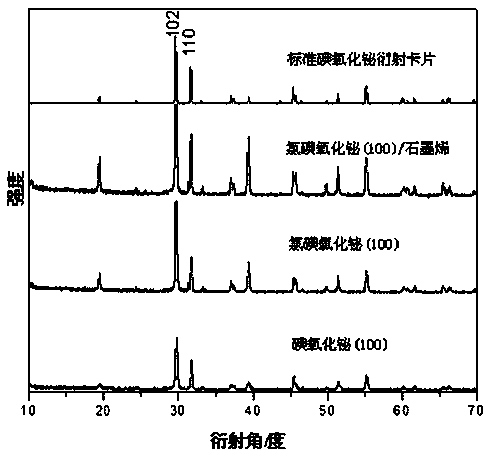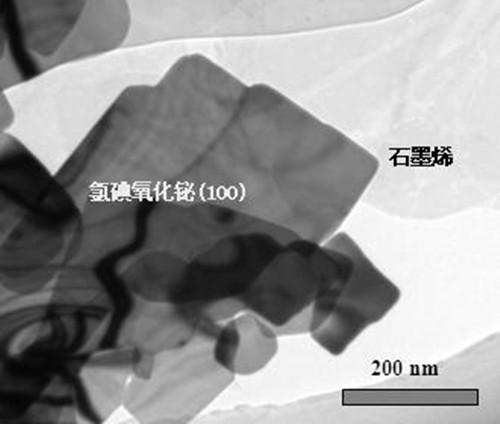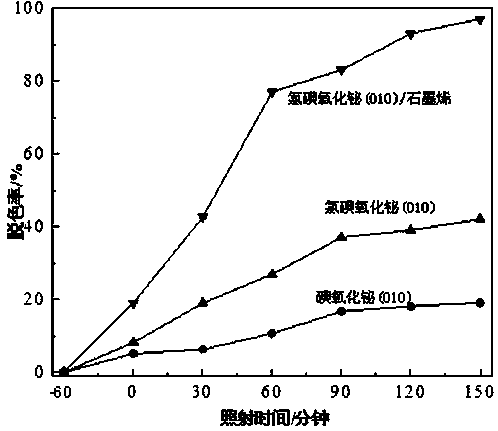Chlorine bismuth oxyiodide (010)/graphene heterostructure and preparation method and application thereof
A technology of bismuth oxychloroiodide and bismuth oxyiodide is applied in the field of bismuth oxychloroiodide/graphene heterojunction and its preparation, which can solve the problems of increased preparation cost, complicated preparation process, long reaction time, etc. Catalytic performance, simple process, good exposure effect
- Summary
- Abstract
- Description
- Claims
- Application Information
AI Technical Summary
Problems solved by technology
Method used
Image
Examples
Embodiment 1
[0025] Step 1, take 0.07g of commercial graphene and add it into deionized water, ultrasonically disperse it at 30°C for 20min, and make A solution;
[0026] Step 2, 5mmol of Bi(NO 3 ) 3 ·5H 2 O was added to 2.0 mol / L HNO 3 , stirred at 80°C until completely dissolved, and made into liquid B;
[0027] Step 3, take 4.94mmol KI and 0.06mmol KCl and dissolve them in deionized water to make solution C;
[0028] Step 4, add the prepared liquid A dropwise to liquid B to form liquid D, wherein Bi(NO 3 ) 3 ·5H 2 The molar ratio of O to (KI+KCl) is 1:1;
[0029] Step 5, slowly drop 2.0 mol / L NaOH solution into D liquid, and adjust the pH value of D liquid to 6;
[0030] Step 6, adding liquid C to liquid D to form liquid E;
[0031] Step 7: Pour liquid E into the reactor, heat the reactor to 170°C, and keep it warm for 24 hours;
[0032] Step 8: After the reactor is cooled, the precipitate in the reactor is washed with absolute ethanol and deionized water in sequence, and drie...
Embodiment 2
[0034] Step 1, 5mmol of Bi(NO 3 ) 3 ·5H 2 O was added to 2.0 mol / L HNO 3 , stirred at 80°C until completely dissolved, and made into liquid A;
[0035] Step 2, take 4.94mmol KI and 0.06mmol KCl and dissolve them in deionized water to make solution B;
[0036] Step 4, add the prepared liquid A dropwise to liquid B to form liquid C, wherein Bi(NO 3 ) 3 ·5H 2 The molar ratio of O to (KI+KCl) is 1:1;
[0037] Step 5, slowly drop 2.0 mol / L NaOH solution into liquid C, and adjust the pH value of liquid C to 6;
[0038] Step 6, adding liquid B to liquid C to form liquid D;
[0039] Step 7, pour liquid D into the reactor, heat the reactor to 170°C, and keep it warm for 24 hours;
[0040] Step 8: After the reactor is cooled, the precipitate in the reactor is washed with absolute ethanol and deionized water in sequence, and dried at 80° C. for 24 hours to obtain bismuth oxychloroiodide (010).
Embodiment 3
[0042] Step 1, 5mmol of Bi(NO 3 ) 3 ·5H 2O was added to 2.0 mol / L HNO 3 , stirred at 80°C until completely dissolved, and made into liquid A;
[0043] Step 2, dissolve 5mmol KI in deionized water to make solution B;
[0044] Step 4, add the prepared liquid A dropwise to liquid B to form liquid C, wherein Bi(NO 3 ) 3 ·5H 2 The molar ratio of O and KI is 1:1;
[0045] Step 5, slowly drop 2.0 mol / L NaOH solution into liquid C, and adjust the pH value of liquid C to 6;
[0046] Step 6, adding liquid B to liquid C to form liquid D;
[0047] Step 7, pour liquid D into the reactor, heat the reactor to 170°C, and keep it warm for 24 hours;
[0048] Step 8: After the reactor is cooled, the precipitate in the reactor is washed with absolute ethanol and deionized water in sequence, and dried at 80° C. for 24 hours to obtain bismuth oxyiodide (010).
PUM
 Login to View More
Login to View More Abstract
Description
Claims
Application Information
 Login to View More
Login to View More - R&D
- Intellectual Property
- Life Sciences
- Materials
- Tech Scout
- Unparalleled Data Quality
- Higher Quality Content
- 60% Fewer Hallucinations
Browse by: Latest US Patents, China's latest patents, Technical Efficacy Thesaurus, Application Domain, Technology Topic, Popular Technical Reports.
© 2025 PatSnap. All rights reserved.Legal|Privacy policy|Modern Slavery Act Transparency Statement|Sitemap|About US| Contact US: help@patsnap.com



